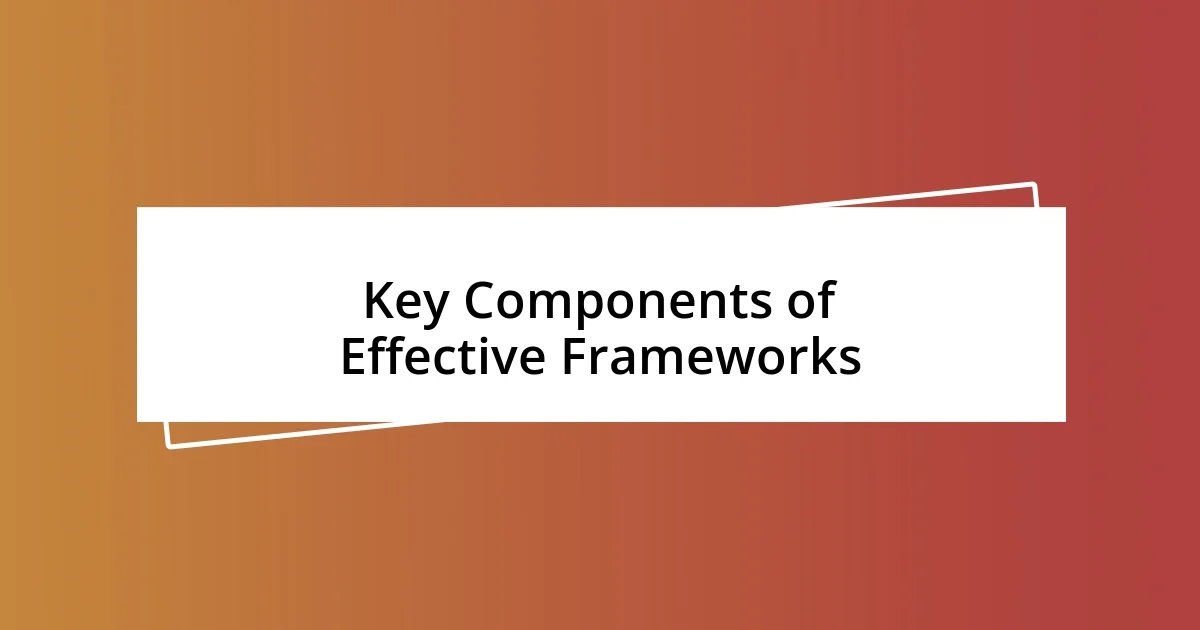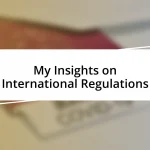Key takeaways:
- Global crypto frameworks vary significantly across countries, impacting innovation and market dynamics, with regions like Singapore fostering growth and others like China imposing strict regulations.
- Effective cryptocurrency regulation should prioritize clarity, adaptability, and stakeholder collaboration to enhance trust and safety, while avoiding stifling innovation.
- Future trends in crypto regulations may include the use of AI for compliance monitoring, the implementation of regulatory sandboxes for testing, and efforts toward global regulatory harmonization to create a more supportive ecosystem.

Understanding Global Crypto Frameworks
Global crypto frameworks refer to the various regulatory, legal, and technological structures put in place to manage cryptocurrency transactions and promote market stability. When I first learned about these frameworks, I was intrigued by how different countries approach regulation. It made me wonder—how can something so innovative be shackled by rules that sometimes seem outdated?
I recall a conversation with a friend who operates a crypto exchange. He explained that navigating the complex patchwork of regulations can feel like walking through a maze blindfolded. Each country has its own set of rules, and that inconsistency can stifle innovation. Understanding these frameworks is crucial for anyone involved in the crypto space, as they shape the landscape in which we operate.
At the same time, I find myself reflecting on the underlying intention of these frameworks: fostering trust and security in a market sometimes viewed with skepticism. I often ask myself, can we really strike a balance between regulation and the freedom to innovate? The answer lies in how well we can adapt to evolving technologies while safeguarding consumers and investors alike.

Importance of Regulation in Cryptocurrencies
Regulation in the cryptocurrency space isn’t just a bureaucratic hurdle; it can actually serve as a catalyst for growth. I remember attending a crypto seminar where the speaker emphasized that well-crafted regulations could lead to increased institutional investment. They argued that fear of fraud or lack of oversight often deters larger players from entering the market. Reflecting on that, I think about how regulation can transform skepticism into confidence, encouraging a broader adoption of digital currencies.
Not all regulations are created equal, though. I’ve seen how some regions embrace a more progressive approach, creating an environment that nurtures innovation. For instance, my friend in Singapore shared how their regulatory framework allows startups to flourish, enabling creativity while still protecting consumers. It made me appreciate the distinction between stifling and supportive regulations, and how critical it is for policymakers to find that sweet spot.
As a frequent investor myself, I often question: how do I protect my assets in such a volatile market? A robust regulatory framework can provide that safety net, setting standards for anti-money laundering (AML) practices and Know Your Customer (KYC) requirements. By ensuring that platforms adhere to these guidelines, we can build a more secure ecosystem, where participants feel their investments are safeguarded.
| Type of Regulation | Impact on the Market |
|---|---|
| Strict Regulations | Can deter innovation but potentially enhance trust among investors. |
| Flexible Regulations | Encourages innovation while maintaining consumer protection. |

Comparative Analysis of Crypto Regulations
Comparing crypto regulations across global jurisdictions reveals striking contrasts that can significantly impact market dynamics. From my conversations with fellow investors, I’ve noted how certain countries, like Malta, adopt a more inviting regulatory framework, aiming to attract blockchain companies with tax incentives and clear guidelines. Conversely, nations with stringent regulations, such as China, can create an environment of uncertainty, compelling many crypto enthusiasts to seek refuge in friendlier territories. This dichotomy underscores how regulation can either entice investment or push it away, truly shaping the crypto landscape.
Here’s a snapshot of the varying regulatory styles and their implications:
- Singapore: Proactive regulatory approach encourages innovation while instilling confidence in investors.
- United States: Fragmented regulations across states create a confusing landscape for businesses.
- European Union: Striving for harmonization but often bogged down by bureaucracy.
- China: Aggressive regulatory stance that stifles local innovation, pushing projects to relocate internationally.
- Canada: Emphasis on consumer protection, balancing regulation with growth potential.
I often find myself reflecting on these differences, especially during discussions at local crypto meetups. It’s fascinating to see how regulations can be a double-edged sword, where the same rules that protect consumers might also deter new startups from entering the market. This exploration not only helps in navigating my investment choices but also drives home the importance of staying informed about the evolving regulatory landscape.

Key Components of Effective Frameworks
A successful global crypto framework must prioritize clarity and transparency. I distinctly remember a discussion at a blockchain conference where clarity was highlighted as essential for building trust. When regulations are complicated or ambiguous, they create a fog of uncertainty. It resonates with me how clearer guidelines not only help investors make informed decisions but also empower innovators to thrive without the fear of inadvertently stepping out of line.
Another crucial element is adaptability; a rigid framework can stifle progress. I think about how, during one of my investment workshops, the topic of legislative updates spurred a lively debate. The consensus was that regulations should evolve with the rapidly changing crypto landscape. This adaptability allows frameworks to accommodate new technologies and methods of transaction, fostering a dynamic environment where creativity can flourish, ultimately benefiting us all.
Moreover, stakeholder collaboration is vital. I often ponder how my relationship with various crypto exchanges could change if they actively engaged in discussions with regulators. Through dialogue, both sides can understand each other’s needs, leading to rules that genuinely serve the industry while protecting consumers. It’s clear to me that when stakeholders work hand-in-hand, the result is a more balanced framework that fosters trust and innovation.

Challenges Facing Global Crypto Regulations
The challenge of effectively regulating the global crypto market often boils down to a fundamental issue: the pace of technological advancement. I remember sitting at a roundtable discussion where someone posed the question, “How can regulations keep up with the rate of innovation in this space?” It struck me that crypto evolves so quickly that by the time a regulation is drafted, the technology may have already moved on. This delay can create loopholes that bad actors exploit, leaving honest projects and investors vulnerable.
Another significant hurdle is the lack of international consensus. During a recent meetup, one participant passionately argued that we’re in a “regulatory race to the bottom,” with countries competing for crypto business but often at the cost of consumer protection. This disjointed approach not only breeds confusion but also undermines trust among global investors. I often wonder how we can foster greater collaboration between nations to create a unified set of regulations that can adapt to this rapidly changing ecosystem.
Moreover, the centralization versus decentralization debate complicates the regulatory landscape. I’ve had countless chats with tech enthusiasts who are excited about the promise of decentralized finance (DeFi). However, they often express frustration over the lack of clear regulations for such innovative structures. I can’t help but ask, do we want regulations that stifle innovation or ones that provide necessary oversight? Balancing the two seems crucial, yet the ongoing tension between regulating decentralized platforms while preserving their core principles continues to pose a daunting challenge for regulators worldwide.

Future Trends in Crypto Regulations
As I consider the future trends in crypto regulations, one thought stands out to me: the increasing role of artificial intelligence in monitoring compliance. I remember being part of a workshop where a presenter demonstrated how AI can sift through vast amounts of trading data in real-time. It made me realize that technology itself could become a regulatory tool, helping to flag suspicious activity much faster than human regulators could. Could this shift in approach provide a more efficient regulatory framework that not only safeguards consumers but also encourages innovation?
Another trend I foresee is the rise of regulatory sandboxes, which allow new products and services to be tested in a controlled environment. Not long ago, I attended a session focused on a country’s initiative where startups could trial their crypto-related technologies with regulatory oversight. This concept resonates with me because it strikes a balance between fostering innovation and ensuring safety. It’s exciting to think that such sandboxes could pave the way for more adaptive and supportive regulatory environments that can respond effectively as new challenges emerge.
Lastly, the move toward global regulatory harmony is something I find profoundly important. During a panel discussion, a regulator touched on the idea of mutual recognition agreements among countries, which really struck a chord with me. Wouldn’t it be beneficial if jurisdictions recognized each other’s regulatory frameworks, reducing the burden on crypto companies striving for compliance? I believe that a unified approach could not only simplify the landscape for businesses but also enhance consumer confidence, creating a more inviting ecosystem for all participants.

Personal Insights on Regulatory Developments
Reflecting on the evolving regulatory landscape, I often find myself pondering the implications of national policies on the broader crypto community. I remember hearing a story from a developer friend whose project faced delays because of sudden regulatory changes in their home country. It made me realize how crucial it is for regulators to communicate transparently with innovators to avoid stifling growth due to sudden shifts in the rules. How can we expect teams to build ground-breaking technologies if they’re constantly looking over their shoulders?
In my discussions with fellow crypto enthusiasts, the topic of regulatory clarity often comes up. One evening, over coffee, a friend shared how their startup had to pivot its model due to ambiguous regulations. The frustration in their voice really resonated with me; it highlighted the challenge that inconsistent guidelines can pose to emerging projects. I can’t help but ask, isn’t it the regulators’ responsibility to create a stable environment where innovation can flourish instead of feeling like it’s constantly under threat?
Observing the global narratives around crypto regulation has sparked my curiosity about the future. I recalled an event where regulators from different countries came together to discuss potential collaborations. I left that meeting feeling hopeful but also aware of the roadblocks we still face. How do we align differing values and approaches without compromising the unique strengths of each regulatory framework? It seems paramount that we find a way to embrace diversity in perspectives while moving towards a more cohesive and supportive regulatory environment.












